When most anglers think of fly fishing, they tend to envision a fisherman standing in the middle of a large river rolling out 70-foot casts to distant lies. In fact, that image is picturesque and at the same time accurate since many of the famous fly fishing streams are indeed large rivers.
Consequently, due to the popularity of big water fly fishing, fly rod and reel manufacturers now produce fast action rods and large arbor reels almost exclusively.
Understand the Key Concepts First
It takes new fly casters years of practice to learn the double haul casting technique that is used to load a fly rod to its maximum potential during a long range cast.
Starting with short range fly casting is still the best possible way to learn the basics of fly casting technique. It is recommended to improve your skills first before attempting to learn either the single haul or the double haul.
But before you can learn proper fly casting technique, here are some concepts that you need to understand.
How Normal Casting Works
All typical fishing lures have a significant amount of weight which enables them to be cast over long distances. Weight is usually measured in ounces or fractions of an ounce.
The weight of the lure causes the fishing rod to bend, called loading, during the back cast which in turn stores energy in the rod. It also needs to be matched with the rod’s action.
When the rod’s forward motion is suddenly halted during the forward cast, all of the energy stored in the rod during the back cast is suddenly transmitted to the lure which causes it to sail through the air toward its intended target.
How Fly Casting Works

Since an artificial fly is made from fur, feathers, and various synthetic materials tied to an almost weightless wire hook, it is very light and has a lot of wind resistance.
So it is simply impossible to cast an artificial fly in the same manner that an angler would cast a conventional fishing lure. Therefore, fly fishers have to use a weighted line instead of a weighted lure to store energy in their fly rods.
Fly Line
There are different types of fly lines, just like there are various kinds of conventional fishing lines. Just a quick rundown:
- Floating fly line – designed to float on the surface of water.
- Sinking fly line – designed to sink below the water’s surface.
- Sink tip fly line – most of the fly line floats while the last few feet are designed to sink. They are made of a thin, braided Dacron core that is coated with a specialized type of plastic which contains millions of tiny glass microbubbles. They also contain powdered Tungsten.
Tapers
By varying the shape and diameter of the coating at any given point, fly line manufacturers can design various fly line tapers, and each has different casting properties.
- Level taper – the easiest to make, so they are the least expensive but the most difficult to cast with.
- Double taper – consists of a belly with a head and a tip on either end. It is meant for fishing at relatively close ranges.
- Weight forward – consists of a running line, a rear taper, a belly, and a front taper. It is specially designed for casting over long distances.
Weight & Action
Just like popular fishing lures, the weight of the fly line needs to be matched with the action of the fly rod.
Fly lines are designated by weighing the first 30 feet of the line in grains (440 grains = 1 ounce), and they are categorized on a scale of 1 to 14 with one weight (1 wt) being the lightest and 14 weight (14 wt) being the heaviest.
A fly rod is also designated by the weight of the fly line. For example, they are designed to cast a 9 ft 5 wt.
The heavier the fly line is, the larger it casts but its landing on water is less delicate. So fly fishers use light fly lines to catch skittish fish in crystal clear water; and heavy fly lines when they need to cast large, wind resistant flies.
How to Cast
Now that you understand the basic concepts of fly casting, let’s discuss how to execute it. For better visualization, the clock face is used as reference for the positions.
Fly casting is divided into two actions: back cast and a forward cast.
But before we go into specifics of actions do the following:
- Strip a long length of the fly line from your fly reel, and then allow it to lie on the water in front of you.
- So once you have plenty of fly line stripped off of your fly reel, hold the fly rod in one hand and grasp the fly line in the other. Start by holding the tip of the rod just above the surface of the water.
Back Cast
To do the back cast, you need to do two motions: a lift and a rear power stroke.
it is important to understand that the lifting motion is performed with the forearm only and with the wrist locked in the forward position.
Then, the “rear power stroke” is performed with the wrist only and with the forearm locked in position.
Steps
Lift
The purpose of the lift is to break the adhesion between the fly line and the water, then get it moving so that you can lift it off the water and cast it into the air behind you.
This is performed with the forearm only while the wrist is locked in the forward position.
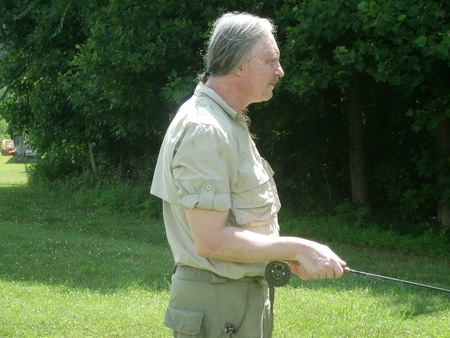
2. Slowly lift the fly line off the water. Increase the speed of your forearm until your rod tip reaches a position approximately equal to 1:30 on a clock face.
Then, at this point, you stop moving your forearm and start moving only your wrist.
Rear Power Stroke
3. To perform the “rear power stroke” you move your wrist from the 1:30 position to the 11:00 o’clock position while applying force to the rod.
Note: It is very important to understand that at this point, you are attempting to cast the fly line high in the air behind you and thus it is imperative that you do not drop your rod tip lower than 11:00 o’clock!
Forward Cast
After the back cast, you have to do a forward cast to launch the fly line in front of you going to your target.
It is divided in two motions: a push and a power stroke.
Also, as it is with the Back Cast, the Forward Cast is performed by first moving the forearm only and then by moving the wrist only
Steps
With your rod tip held at 11:00 and while the fly line is on the air after completing the back cast, you need to briefly pause to allow the line to straighten out behind you entirely. This is “finishing your back cast.”
When you feel a slight tug at the end of your fly rod, this is your indicator that it is time to start your forward cast.
Push
1. Then, to perform the Forward Cast, you start by once again locking your wrist and moving only your forearm.
However, when performing this motion, you need to move your forearm forward while causing your wrist to move horizontally in a straight line by “pushing” your forearm forward until your rod tip reaches the 12:00 o’clock position.
Power Stroke
2. Then, at that point, you stop moving your forearm and start moving only your wrist to perform the “power stroke” until the rod tip reaches the 1:00 o’clock position in front of you.
Common Mistakes
Rod Position
The most common mistake that people make when performing the back cast is dropping their rod tip past the 11:00 o’clock position to 10:00 o’clock or even 9:00 o’clock. So even if you have heard of the phrase “10 to 2” about fly casting, ignore it because it’s WRONG!
Cast Timing
Anglers also tend to start their forward cast too soon after performing their back cast. Consequently, this causes the end of the fly line to snap like a bull whip and can also snap the fly off the end of your fly line leader!
Motion
When doing the forward cast, people tend to pivot their forearm around their elbow in an arc instead of moving it forward in such a way that it pushes their wrist straight forward horizontally.
Rotating your forearm around your elbow will cause the tip of your fly rod to dive to the ground as you finish your forward cast. So drive your fly line straight down instead out into the air in front of you.
Extra Tip!
When performing the forward cast, it is helpful to use the tip of your fly rod to aim the fly line at your target. Most importantly, use the tip of your fly rod to target the fly line above the water and not on its surface.
The idea is, you want your fly line to straighten out above the surface of the water and slowly float down to land on the water instead of slapping the water as it falls.
Train Your Muscles
Follow this exercise to instill these motions correctly in your muscle memory:
1. Set your fly rod aside.
2. Cup the elbow of your casting arm with the palm of your other hand.
3. Slowly perform each movement and each action numerous times without the fly rod in your hand.
This will teach you to keep your elbow close to your body when casting. It will make your casting motion far more efficient and it will train your body to do it correctly.
Once you have these programmed to your muscle memory, pick up your fly rod and practice until you can place the fly on target every time without the fly line snapping behind you or driving to the ground in front of you.

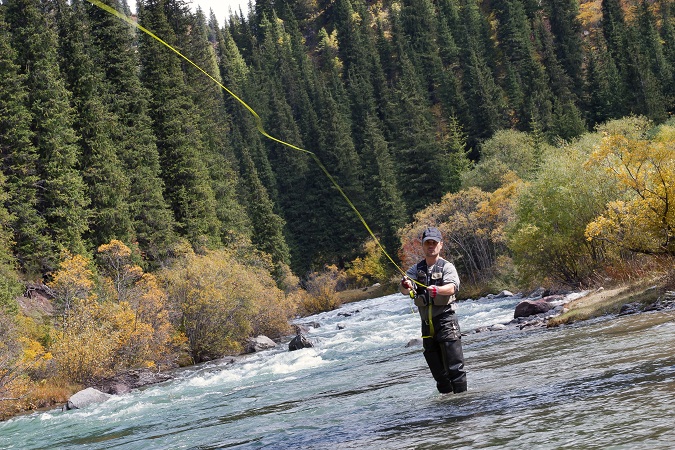
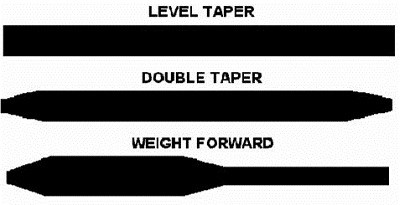
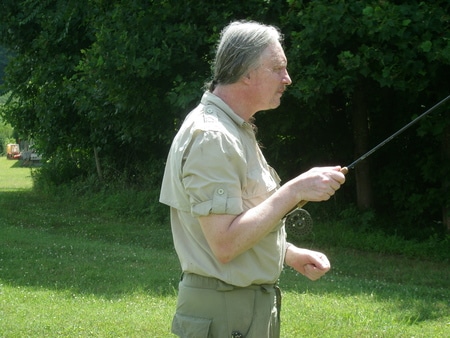


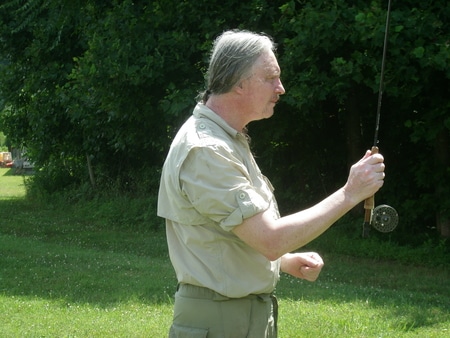
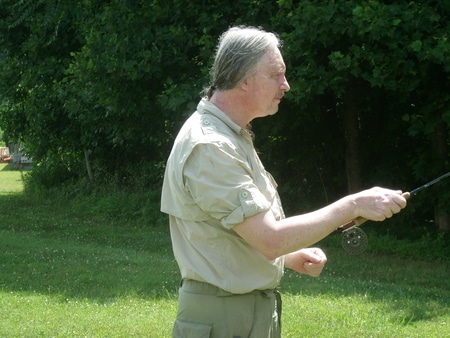
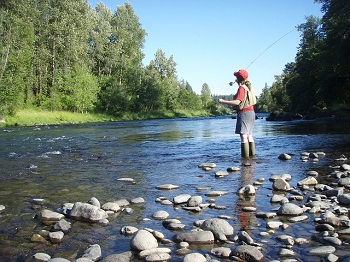
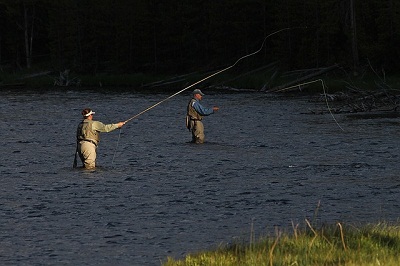


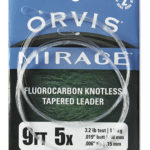



Comments are closed.